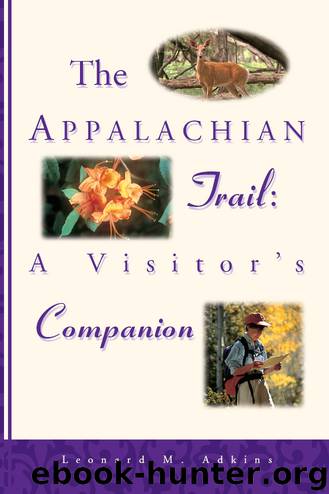The Appalachian Trail Visitor's Companion by Leonard Adkins

Author:Leonard Adkins
Language: eng
Format: epub
ISBN: eBook ISBN: 9780897328524
Publisher: Menasha Ridge Press
Published: 1998-04-17T16:00:00+00:00
Yellow lady’s slipper
Viper’s bugloss
Flame azalea
Bloodroot
To show that mountain laurel and rhododendron are not just southern plants, it is possible to find the pink blossoms of rhodora (a relative of the mountain laurel and the rhododendron—all of which belong to the Heath Family) adding color in the spring to the bogs of the 100 Mile Wilderness of Maine.
From June into September (and sometimes even into October), you should search for and stop to study the unique Indian pipe, which grows in heavily shaded areas. Although there has been recent research to suggest that Indian pipe is in a symbiotic relationship with its host, the plant has historically been recognized as being saprophytic, gaining its nourishment from decaying matter through osmosis. Containing no chlorophyll (the substance that gives plants their green color), this herb rises from the soil on translucent, waxy-looking stems as the pinkish white flower nods back toward the ground, giving the whole plant the appearance of a fancily carved soapstone pipe.
The partridgeberry is another an interesting plant that warrants getting down on hands and knees to observe. Two white flowers, blooming in early summer, fuse together to produce one tiny berry. A close examination of that berry, which changes from green to red during the cooler months, will reveal two scars—one from each flower. The partridgeberry is also an important ground cover; its roots are shallow, but they intertwine to form a compact mat that helps stabilize the soil and keep it from washing away.
Sometimes the AT’s protected corridor helps preserve habitat for rare, threatened, or endangered plants, as in the case of the June-blooming Gray’s lily. Named for Dr. Asa Gray, the famous American botanist, this lily is sometimes referred to as the Roan lily, after the mountain on which Dr. Gray first discovered it. In fact, as far as research can determine, Gray’s lily is rarely found anywhere else on the AT except Roan Mountain and a few of its neighboring balds. (The Appalachian Trail Conference is involved in a continuing study to determine where and what other types of rare, threatened, or endangered plants may happen to be growing within the trail’s corridor.)
At other times, a plant that is widespread in the eastern part of the United States is found only in isolated spots along the AT. Climbing fumitory grows on wooded hillsides and rocky slopes from North Carolina all of the way north into Ontario, Canada. Yet this plant, which blooms in June and is also called Allegheny-vine or mountain-fringe, has only been identified at one spot along the entire length of the AT—Fumitory Rocks upon the crest of Peters Mountain in Pennsylvania.
By the time the warmer temperatures and breezes of July and August blow across the AT ridgelines, many of the earlier flowers will have disappeared, but growing next to their developing berries and fruits will be black cohosh, oxeye daisy, black-eyed Susan, bergamot (Georgia to southern New England), bee balm (Georgia to New York), touchme-not, boneset, New York ironweed (Georgia to New York),
Download
This site does not store any files on its server. We only index and link to content provided by other sites. Please contact the content providers to delete copyright contents if any and email us, we'll remove relevant links or contents immediately.
Giovanni's Room by James Baldwin(7189)
The Plant Paradox by Dr. Steven R. Gundry M.D(2545)
The Stranger in the Woods by Michael Finkel(2453)
Miami by Joan Didion(2322)
Wild: From Lost to Found on the Pacific Crest Trail by Cheryl Strayed(2213)
INTO THE WILD by Jon Krakauer(2152)
DK Eyewitness Top 10 Travel Guides Orlando by DK(2129)
Trail Magic by Trevelyan Quest Edwards & Hazel Edwards(2125)
Vacationland by John Hodgman(2089)
The Twilight Saga Collection by Stephenie Meyer(2083)
Nomadland by Jessica Bruder(2014)
Birds of the Pacific Northwest by Shewey John; Blount Tim;(1924)
The Last Flight by Julie Clark(1908)
Portland: Including the Coast, Mounts Hood and St. Helens, and the Santiam River by Paul Gerald(1883)
On Trails by Robert Moor(1851)
Deep South by Paul Theroux(1785)
Blue Highways by William Least Heat-Moon(1721)
Trees and Shrubs of the Pacific Northwest by Mark Turner(1680)
1,000 Places to See in the United States and Canada Before You Die (1,000 Places to See in the United States & Canada Before You) by Patricia Schultz(1607)
